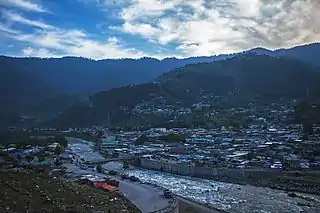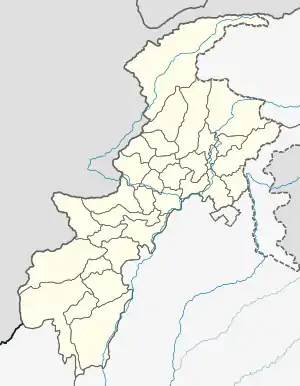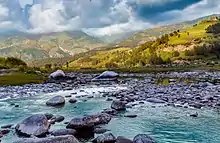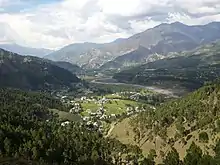Balakot
Balakot (Urdu: بالاکوٹ) is a town in Mansehra District in the Khyber Pakhtunkhwa province of Pakistan. The town was destroyed during the 2005 Kashmir earthquake, but was later rebuilt with the assistance of the Government of Pakistan and Saudi Public Assistance for Pakistan Earthquake Victims (SPAPEV),[1] a Saudi relief organisation.
Balakot
بالاکوٹ | |
|---|---|
 | |
 Balakot  Balakot | |
| Coordinates: 34.54°N 73.35°E | |
| Country | |
| Province | Khyber Pakhtunkhwa |
| Time zone | UTC+05:00 (PST) |
| Languages | Hindko |
Geography

Balakot is located on the right bank of the Kunhar River. It is almost at two-thirds of the length of river from it its origin at Lake Dharam Sar deep in the Kaghan Valley, before it confluence with Jehlum River.

The lower area below Balakot, sometimes referred to as Nainsukh Valley, is temperate while Kaghan Valley above Balakot City is cold enough to turn the whole area to freezing in the winter. Kaghan valley is a pleasant summer destination. Its upper part from Naran upstream lacks the monsoon but the lower part get it well and so is forested.
Balakot is now expanding city and centre among distant northern parts of Pakistan. Smaller hamlets are located in the terraced mountains around it.
Climate
Balakot has a humid subtropical climate (Köppen climate classification Cfa) with hot summers and cool winters. Rainfall in Balakot is much higher than in most other parts of Pakistan. The heaviest rainfall occurs either in late winter (February–March) associated with frontal systems, or in the monsoon season (June–August); however, all months see significant rainfall on average.
| Climate data for Balakot | |||||||||||||
|---|---|---|---|---|---|---|---|---|---|---|---|---|---|
| Month | Jan | Feb | Mar | Apr | May | Jun | Jul | Aug | Sep | Oct | Nov | Dec | Year |
| Record high °C (°F) | 24.4 (75.9) |
25.2 (77.4) |
31.1 (88.0) |
36.0 (96.8) |
43.3 (109.9) |
42.1 (107.8) |
41.2 (106.2) |
39.7 (103.5) |
35.2 (95.4) |
33.9 (93.0) |
29.0 (84.2) |
24.7 (76.5) |
43.3 (109.9) |
| Average high °C (°F) | 13.9 (57.0) |
15.2 (59.4) |
19.3 (66.7) |
25.9 (78.6) |
31.3 (88.3) |
35.5 (95.9) |
32.3 (90.1) |
31.2 (88.2) |
31.0 (87.8) |
27.4 (81.3) |
22.2 (72.0) |
15.9 (60.6) |
25.1 (77.2) |
| Daily mean °C (°F) | 8.1 (46.6) |
9.5 (49.1) |
13.5 (56.3) |
19.3 (66.7) |
24.3 (75.7) |
28.1 (82.6) |
26.8 (80.2) |
25.9 (78.6) |
24.0 (75.2) |
19.3 (66.7) |
14.2 (57.6) |
9.5 (49.1) |
18.5 (65.4) |
| Average low °C (°F) | 2.2 (36.0) |
3.8 (38.8) |
7.6 (45.7) |
12.7 (54.9) |
17.4 (63.3) |
20.7 (69.3) |
21.2 (70.2) |
20.6 (69.1) |
17.1 (62.8) |
11.3 (52.3) |
6.1 (43.0) |
3.1 (37.6) |
12.0 (53.6) |
| Record low °C (°F) | −3 (27) |
−2.2 (28.0) |
−1 (30) |
3.9 (39.0) |
8.0 (46.4) |
10.0 (50.0) |
15.0 (59.0) |
13.3 (55.9) |
10.0 (50.0) |
5.2 (41.4) |
1.7 (35.1) |
−1.3 (29.7) |
−3 (27) |
| Average precipitation mm (inches) | 105.4 (4.15) |
156.1 (6.15) |
195.9 (7.71) |
122.5 (4.82) |
80.5 (3.17) |
107.3 (4.22) |
384.3 (15.13) |
311.4 (12.26) |
100.8 (3.97) |
48.9 (1.93) |
44.0 (1.73) |
87.5 (3.44) |
1,744.6 (68.68) |
| Source: NOAA (1971–1990)[2] | |||||||||||||
Administration
Balakot is one of the main cities of Mansehra District. It serves as the chief city of Balakot Tehsil, which is the largest Tehsil of Mansehra District. It has also a Union Council and administers the many surrounding smaller towns and villages.[3]
History
Early history
The known history of the city is not well recorded before the British Period. Archaeologists from Hazara University, however, have found terracotta remains and terracotta figurines from distant points in the high altitudes around the area.[4] They might shed light on earlier inhabitants of the area.
Old graveyards also suggest the linkages toward pre-Muslim occupants who later converted to Islam.[5]
Mughal Empire
Mughals ultimately had this place under their control and there is a local tradition of Mughal Queen, Nur Jahan, while on the way to Kashmir, used the route below Balakot near Garhi Habibullah Khan.
Sikhs
Battle of Balakot is the defining battle in which Syed Ahmad and Shah Ismail were killed.[6][7][8] The historical records give a detailed account of the Tehreek-ul-Mujahideen from Raebareli under the Syed Ahmad Barelvi and Shah Ismail. They were accompanied by many followers who believe Syed Ahmad to be a Khalifah, i.e. Caliph, from Raebareli and some local followers of Swati and Syed clans. Balakot was a refuge to them after being ousted from Swabi and Amb State. The Sikhs, under the banner of Lahore Durbar fought the defining battle against this movement and killed every one in general. However, there are local tradition of revering different sites in the hills, by making small stone enclosure where the blood of the wounded Mujahideen was supposedly spilled. They name it as, 'Shaheed'. For the sake of this event, Balakot City is sometime also referred to as, Shuhada ki Sarzameen, i.e. The Land of Martyrs. Sikh Army tried to penetrate from the Garhi Habibullah (15 km downstream) with armies from Kashmir but were put to hold till the reinforcement arrived from Lahore via Timri near Shinkiari. On a little mound in the north of the city, by the Rou Nala, the Battle of Balakot was fought on 6 May 1831. Sikhs became victorious and all the Mujahideens including Syed Ahmad and Shah Ismail were killed.[9]
Mahtab Singh, a writer of the history of Hazara to the wish of James Abbot, writes that Sikhs, to stop the movement to continue any further, reopened the grave of Syed Ahmad and set the body into the Kunhar Rive[10]r. It may possibly be right as in Talhatta 10 km down stream another grave is also dedicated to him. Local tradition also support that it is the head buried here.
It was a brutal and fearsome rule which ended after James Abbot's coming in Hazara and things changed after he incited local chiefdom against Sikhs in his own bid. There have been many skirmishes between locals and Shiks forces. One famous event happened in 1844 when Gulab Singh, Maharaja of Kashmir sent a campaign to Chilas under Diwan Ibrahim, which was effectively destroyed by local populations in Kaghan Valley at Diwan Bela, named after him.
British Rule
After James Abbot coming to the region in early 1840s, Sikhs were kept in check in upper Hazara. And he was able to wage war on Sikhs with this local support in Haripur. It was brutal rule of Sikhs which made him lead local chiefs and their forces. He sat in Balakot and distributed the land to the people in a summary settlement.[11]
During the War of Independence 1857, no local chief is reported to have revolted. It is rather the other side of the history that local chiefs helped British Army to bring down mutineers of Hoti Garrission, Mardan. 55th Native Infantry mutineers were trying to seek refuge in Kashmir State, however they were only able to cross Indus in Kohistan and went up the hilly route and caught near Lake Dudipatsar by local forces of the Kaghan chiefs, Kohistanis and Gujjars. The whole gorge is now known as Purbi Nar means the gorge of Eastern People i.e. people from Bengal. Few escaped and captured by Kashmir State and then handed over to British Army for execution.[11]
Rest of the British Period gone well and many remains of British Period structures can be seen. Examples are Dakbungalows at Burawai (now ruined PWD Rest House), Lalazar, Battakundi, Naran (now WAPDA Rest House), Kamal Ban, Sharan, Shogran, Balakot can be seen. There are number of bridges also found.
Independence 1947
Oral tradition says that there were many Hindu and Sikh inhabitants, most of whom were Khatris who decided to leave for India after partition. No reports of any riots emerged from the time. However, the parties were launched to put the Kashmir State Army on hold along current Line of Control from all the villages around Balakot.
The Jaish-e-Mohammed militant group used to operate from the region.[12][13] A 2004 United States Department of Defense document stated that there was a JeM training camp in Balakot.[14][15] However, according to analysts, the militants left Balakot after the earthquake in 2005 to avoid detection by the international aid groups arriving to provide relief.[16]
2005 earthquake
The town was completely destroyed in a destructive earthquake on 8 October 2005. The fault almost passes through the main bazaar of Balakot. It follows the hilly area to the north up to Allai and leads to the Bagh in Azad Jammu & Kashmir from the villages of Balakot like Kanshian and Jabri Kaleesh. This fault line – the Balakot-Bagh fault – is said to be the source of the Kashmir earthquake.[17] The estimated death toll from the Balakot town and the districts in the affected Kashmir area was put at 73,000 with some sources claiming the number is over 80,000.[18] The hillside town of Balakot, comprising 12 union councils with a population of 30,000 people, was completely destroyed by the earthquake on 8 October 2005. Over 90 per cent of the houses were reduced to muddy smears. The survivors will be relocated to the New Balakot City, currently being developed near Mansehra.
The United Arab Emirates volunteered to rebuild this town into an improved one with housing colonies, schools, hospitals, and other civic facilities. However the Pakistan government has announced that the city will be relocated[19] about 20 km away at a safer spot with more earthquake-proof buildings (see section below).
New Balakot City
After the earthquake, it was discovered that the city was built on geological fault lines and the government recommended moving the residents 15 miles away to Bakarial. Many residents, however, were reluctant to leave and vowed to rebuild the town.[20] The new site was decided to be renamed to "New Balakot City" and the original town of Balakot to be preserved as "national heritage".[21]
In 2011, it was reported that many residents of Balakot had been rebuilding their homes and businesses in the town, despite a government ban.[22]
A decade after the earthquake, the New Balakot City was still being constructed and many residents still lived in temporary earthquake-resistant shelters.[23] Amid the locals' discontent, the Pakistani government cited the problem of acquiring the land at Bakrayal as a reason for the delay due to a dispute between the national and provincial government as well as the landowners.[23] There are observers who also note that political patronage diverted aid away from those who need it.[18] There are those who started rebuilding their houses in the old city. By 2006, construction of New Balakot City resumed.[24]
2019 bombing by the Indian Air Force
In the early morning hours of 26 February Indian warplanes crossed the de facto border in the disputed region of Kashmir,[25] and dropped bombs in the vicinity of Balakot.[26][27]
Pakistan's military, the first to announce the airstrike on 26 February morning,[28] described the Indian planes as dropping their payload in an uninhabited wooded hilltop area near Balakot.[29]
India, confirming the airstrike later the same day, characterised it to be a preemptive strike directed against a terrorist training camp, and causing the deaths of more than 100 terrorists.[30] Analysis of open-source satellite imagery by the Atlantic Council's Digital Forensics Laboratory,[31] San Francisco-based Planet Labs,[32] European Space Imaging,[33] and the Australian Strategic Policy Institute,[34] has concluded that India did not hit any targets of significance on the Jaba hilltop site in the vicinity of Balakot.[35][36]
On 10 April 2019, some international journalists, who were taken to the Jaba hilltop in a tightly controlled trip after "45 days" of the strike arranged by Pakistani government, found the largest building of the site to show no evidence of damage or recent rebuilding.[37][38][39][40]
Ethnicity
The majority of the population are speakers of Hindko,[41] an Indo-Aryan language closely related to Punjabi, and also spoken in the rest of Mansehra District. There are also speakers of Gujari. The main city area of Balakot is inhibited by Gujjar, Awan, Swati, Syed, Turk, Mughal and Hanki [Yousafzai, Madakhel]tribes.
Transportation
In 1965, a bridge was built in Balakot over the Kunhar river called the Ayub Bridge. The bridge connects Balakot, as well as the Kaghan valley, with the rest of Pakistan.[42]
References
- "Saudi Public Assistance for Pakistan Earthquake Victims". Archived from the original on 21 December 2018. Retrieved 9 October 2019.
- "Balakot Climate Normals 1971–1990". National Oceanic and Atmospheric Administration. Retrieved 16 January 2013.
- Tehsils & Unions in the District of Mansehra Archived 18 July 2011 at the Wayback Machine
- "Index of /culture/documents/publications". unesco.org.pk. Retrieved 30 November 2018.
- Ali1, Shah2, Hameed3,Ashfaq4, Muhammad5 (2011). "Archaeological Explorations in Balakot, District Mansehra, 2006–07: A Preliminary Report" (PDF). Pakistan Heritage. 3: 149–160.CS1 maint: multiple names: authors list (link)
- eBook in Urdu language on Shah Ismail Shaheed with introduction by Abu Ala Maududi, Published 1 October 1943 by Qaumi Kutub Khana, Lahore
- Taqwiyat-ul-Iman (Strengthening of the Faith) an eBook translated in English and originally written by Shah Ismail Dehlvi on islamhouse.com website
- Profile of Dehlvi on books.google.com website Retrieved 16 August 2018
- https://economictimes.indiatimes.com/news/politics-and-nation/balakot-deserves-a-bollywood-encore/articleshow/68173459.cms
- Panni, Sherbahadur Khan. Tareekh-i-Hazara. Lahore.
- Watson, H.D. (1908). Gazetteer Of The Hazara District, 1907 (PDF). London: Chatto & Windus. pp. 160–161.
- "Treasury Targets Pakistan-Based Terrorist Organizations Lashkar-E Tayyiba and Jaish-E Mohammed". treasury.gov.
- VanSickle, Abbie (19 November 2016). "Small-Town "Terrorists" : The Infamous Post-9/11 California "Sleeper Cell" Case Continues to Unravel".
- "US knew of JeM terror camp in Pakistan's Balakot 15 years ago". livemint.com. 26 February 2019. Retrieved 1 March 2019.
- "Department of Defense Joint task force report leaked by WikiLeaks" (PDF).
- Maria Abi-Habib, After India's Strike on Pakistan, Both Sides Leave Room for De-escalation, The New York Times
- "Learning from Earthquakes: The Kashmir Earthquake of October 8, 2005: Impacts in Pakistan" (PDF). EERI. February 2006. Retrieved 20 June 2018.
- "The Balakot Earthquake: Ten years on – OpenLearn – Open University". open.edu. Retrieved 19 June 2018.
- Over 80% of the building collapsed and several schools where most of the students were buried alive.BBC NEWS – Pakistan to move quake-hit town
- Quake-Stricken Town Is to Move, Saddening Survivors, The New York Times
- New Balakot City: an unfulfilled promise to earthquake survivors
- Ban on reconstruction violated in Balakot, The Dawn
- "Broken city, broken promises in Kashmir". BBC News. 8 October 2015. Retrieved 19 June 2018.
- Sadaqat, Muhammad (28 January 2016). "New Balakot project: Construction of Bakriyal city to resume in a week – The Express Tribune". The Express Tribune. Retrieved 19 June 2018.
- Joanna Slater; Niha Masih (15 February 2019), "Modi vows action after dozens die in deadliest attack in Indian-held Kashmir in 3 decades", Washington Post Quote: "Both India and Pakistan claim the Himalayan region of Kashmir, but it has been divided between them for more than 70 years."
- Joanna Slater (26 February 2019), "India strikes Pakistan in severe escalation of tensions between nuclear rivals", Washington Post
- Michael Safi; Mehreen Zahra-Malik; Azar Farooq (26 February 2019), "'Get ready for our surprise': Pakistan warns India it will respond to airstrikes", Guardian Quote: "Pakistan, ... said the war planes made it up to five miles inside its territory"
- Michael Safi; Mehreen Zahra-Malik; Azar Farooq (26 February 2019), "'Get ready for our surprise': Pakistan warns India it will respond to airstrikes", Guardian Quote: "Pakistan, which was the first to announce the incursion, ..."
- Maria Abi-Habib; Austin Ramzy (25 February 2019), Indian Jets Strike in Pakistan in Revenge for Kashmir Attack Quote: "A spokesman for Pakistan’s armed forces, Maj. Gen. Asif Ghafoor, on Tuesday posted on Twitter four images of a forested area pockmarked with small craters and debris, which he said was the site of Indian airstrikes."
- Slater, Joanna; Constable, Pamela (27 February 2019). "Pakistan captures Indian pilot after shooting down aircraft, escalating hostilities". The Washington Post. Archived from the original on 27 February 2019. Retrieved 27 February 2019.
- @DFRLab (28 February 2019), "Surgical Strike in Pakistan a Botched Operation? Indian jets carried out a strike against JEM targets inside Pakistani territory, to questionable effect", Medium Quote: "Indian fighter jets carried out strikes against targets inside undisputed Pakistani territory, but open-source evidence suggested that the strike was unsuccessful."
- Martin Howell; Gerry Doyle; Simon Scarr (May 2019), Satellite images show buildings still standing at Indian bombing site, Reuters Quote: "The images produced by Planet Labs Inc, a San Francisco-based private satellite operator, show at least six buildings on the madrasa site on 4 March, six days after the airstrike. ... There are no discernible holes in the roofs of buildings, no signs of scorching, blown-out walls, displaced trees around the madrasa or other signs of an aerial attack."
- European Space Imaging (8 March 2019), PAKISTAN: Satellite Imagery confirms India missed target in Pakistan airstrike Quote: " ... said Managing Director Adrian Zevenbergen. '... The image captured with Worldiew-2 of the buildings in question shows no evidence of a bombing having occurred. There are no signs of scorching, no large distinguishable holes in the roofs of buildings and no signs of stress to the surrounding vegetation.' "
- Marcus Hellyer; Nathan Ruser; Aakriti Bachhawat (27 March 2019), "India's strike on Balakot: a very precise miss?", The Strategist, Australian Strategic Policy Institute Quote: "But India’s recent air strike on a purported Jaish-e-Mohammad terrorist camp in Balakot in Pakistan on 26 February suggests that precision strike is still an art and science that requires both practice and enabling systems to achieve the intended effect. Simply buying precision munitions off the shelf is not enough."
- Sameer Lalwani; Emily Tallo (17 April 2019), "Did India shoot down a Pakistani F-16 in February? This just became a big deal.", Washington Post Quote: " Open-source satellite imagery suggests India did not hit any targets of consequence in the airstrikes it conducted after the terrorist attack on the paramilitaries.
- Michael Safi; Mehreen Zahra-Malik (5 March 2019), "Kashmir's fog of war: how conflicting accounts benefit both sides:India and Pakistan's differing narratives are not unusual in the social media age, say experts", Guardian Quote: "Analysis of open-source satellite imagery has also cast doubt on India’s claims. A report by the Atlantic Council’s Digital Forensic Research Lab was able to geolocate the site of the attack and provide a preliminary damage assessment. It compared satellite images from the days before and after India’s strike and concluded there were only impacts in the wooded areas with no damage visible to surrounding structures."
- Martin Howell; Salahuddin; Reuters (11 April 2019), "Inside the Pakistani Madrasa Where India Said It Killed Hundreds of 'Terrorists", The New York Times Quote: "Those visiting the site on Wednesday didn't see any signs that there had been significant building work to either clear structures or erect new ones. And the vegetation didn't appear to have suffered the stress that might be expected from a missile attack."
- BBC (10 April 2019), Balakot air strike: Pakistan shows off disputed site on eve of India election Quote: "They were given access to an Islamic school in Balakot, where Indian media say militants were killed in retaliation for an attack in Kashmir. The large building appeared to be fully intact ..."
- Agence France Presse (11 April 2019), "Pakistan takes media, diplomats on visit to Indian strike site", france24, AFP Quote: "International outlets which visited the Indian air strike site in Pakistan found no evidence of a major terrorist training camp – or of any infrastructure damage at all."
- Siobhan Heanue (14 April 2019), "The remote school at the centre of a dispute between nuclear neighbours Pakistan and India", Australian Broadcasting Corporation (ABC) Quote: "One thing is clear: India's claim that it destroyed a militant training camp and killed more than 300 extremists cannot be backed up by the evidence. More than a month after India launched airstrikes inside Pakistan in retaliation for a militant attack that killed 40 paramilitary troops in Kashmir, foreign media have been allowed to see the areas hit."
- Hallberg, Calinda E.; O'Leary, Clare F. (1992). "Dialect Variation and Multilingualism among Gujars of Pakistan". In O'Leary, Clare F.; Rensch, Calvin R.; Hallberg, Calinda E. (eds.). Hindko and Gujari. Sociolinguistic Survey of Northern Pakistan. Islamabad: National Institute of Pakistan Studies, Quaid-i-Azam University and Summer Institute of Linguistics. pp. 91–196. ISBN 969-8023-13-5. p. 135.
- "Balakot bridge's repair restores KP-GB traffic," Dawn.
